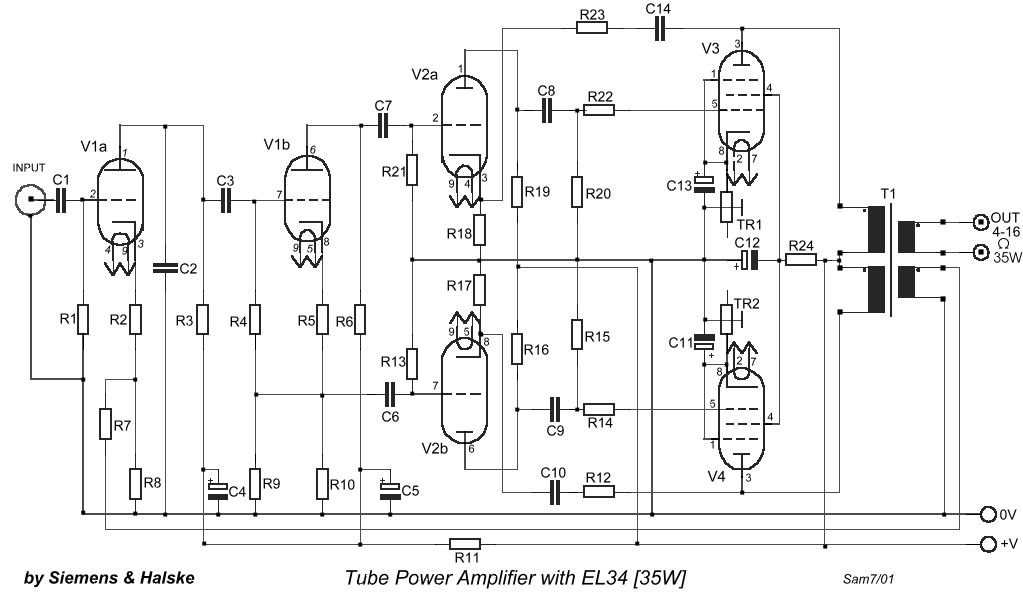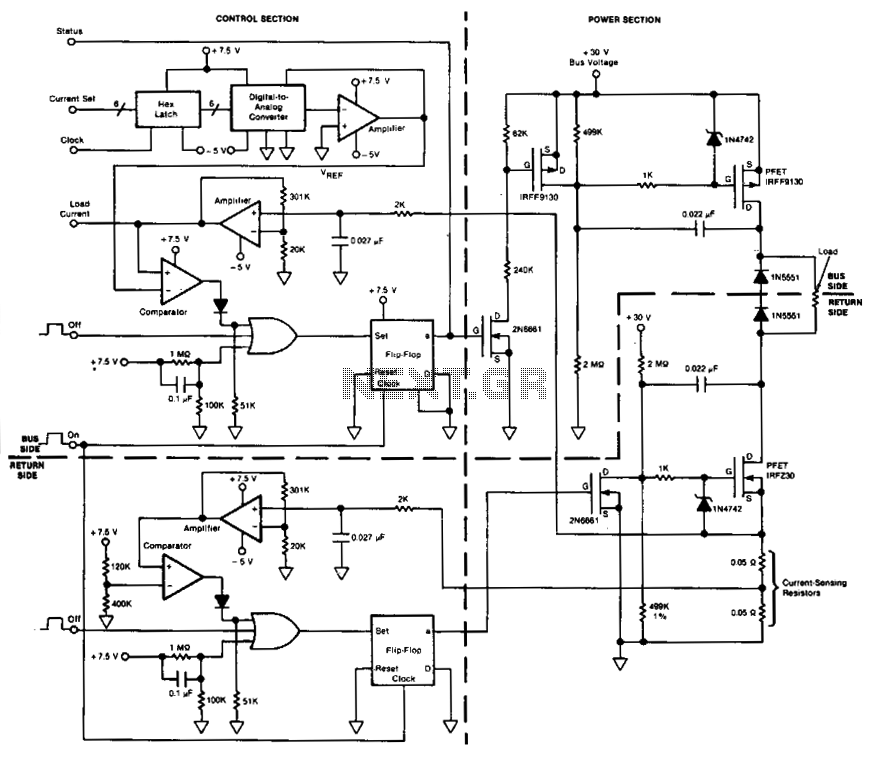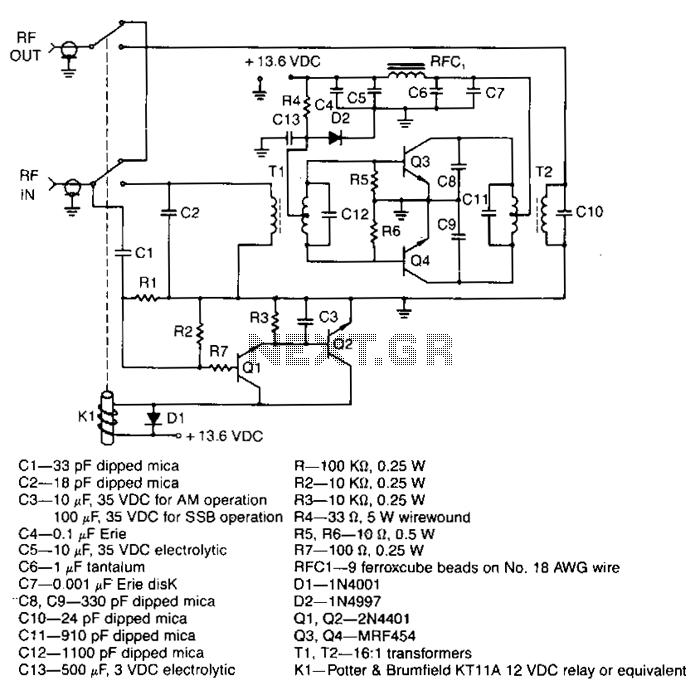
tube power amplifier with el34 35w

This is a classic design of a final amplifier rated at 35 W, utilizing two EL34 tubes in a push-pull configuration. The design originated from Siemens and Halske, dated March 24, 1953, with the code SV410/1. The amplifier was operational from 1954 until 1989, functioning for an average of 15 hours per day. It did not exhibit significant damage beyond the routine replacement of tubes, resistors, and capacitors due to natural wear and tear. A notable modification was made when the tube rectifier was replaced with diodes. The primary challenge for those attempting to reproduce this amplifier will be sourcing the output transformer, a common issue for tube amplifier designs. The existing code may assist in locating a suitable transformer, which can be substituted with a standard output transformer compatible with EL34 tubes. Constructing this amplifier requires considerable expertise and caution due to the high voltage involved, which poses a risk of electric shock.
The described amplifier is a push-pull design that leverages the characteristics of the EL34 vacuum tubes to achieve a power output of 35 watts. The push-pull configuration allows for improved efficiency and reduced distortion compared to single-ended designs, making it a preferred choice for audio applications. The amplifier's circuit typically includes a phase splitter to drive the two EL34 tubes, ensuring that one tube amplifies the positive half of the audio signal while the other amplifies the negative half.
The power supply section of the amplifier is critical, especially considering the original design utilized a tube rectifier. Replacing it with diodes simplifies the power supply design and enhances reliability, as diodes have a longer lifespan and better thermal stability. The output transformer is a pivotal component, as it matches the high impedance of the tubes to the lower impedance of the speakers. The transformer must be selected carefully; it should be rated to handle the power output and have the appropriate turns ratio to ensure optimal performance.
Safety precautions are paramount when working with high-voltage tube amplifiers. Proper insulation, secure connections, and adherence to safety protocols are essential to prevent electric shock. Individuals attempting to construct this amplifier should have a solid understanding of electronics, particularly in high-voltage applications, and should be familiar with soldering techniques and circuit assembly.
In summary, this amplifier design represents a historical yet functional piece of audio technology, requiring both skill and careful consideration in its construction and maintenance.It`s a classic designing of final amplifier 35 W, with two EL34 in push-pull, from the Siemens and Halske, with year of designing 24/3/1953 and code SV410/1. The amplifier it worked from 1954 until 1989, whenever it came also out except operation, with mean of operation 15 hours per day.
It did not present particular damage beyond the replacement of tubes, resistances and capacitors, result of natural deterioration. A essential change became with the replacement of restoring provision from tube, with diodes. The alone problem that will exist, for those who they try his manufacture, will be the transformer of expense, (it is in effect for all the tube manufactures), one and code that exists it will help. It can be replaced with a classic transformer of expense suitable for EL34. In his manufacture it needs (it is in effect for all the corresponding circuits), enough experience and attention in high voltage, danger of ELECTRIC SHOCK.
🔗 External reference
The described amplifier is a push-pull design that leverages the characteristics of the EL34 vacuum tubes to achieve a power output of 35 watts. The push-pull configuration allows for improved efficiency and reduced distortion compared to single-ended designs, making it a preferred choice for audio applications. The amplifier's circuit typically includes a phase splitter to drive the two EL34 tubes, ensuring that one tube amplifies the positive half of the audio signal while the other amplifies the negative half.
The power supply section of the amplifier is critical, especially considering the original design utilized a tube rectifier. Replacing it with diodes simplifies the power supply design and enhances reliability, as diodes have a longer lifespan and better thermal stability. The output transformer is a pivotal component, as it matches the high impedance of the tubes to the lower impedance of the speakers. The transformer must be selected carefully; it should be rated to handle the power output and have the appropriate turns ratio to ensure optimal performance.
Safety precautions are paramount when working with high-voltage tube amplifiers. Proper insulation, secure connections, and adherence to safety protocols are essential to prevent electric shock. Individuals attempting to construct this amplifier should have a solid understanding of electronics, particularly in high-voltage applications, and should be familiar with soldering techniques and circuit assembly.
In summary, this amplifier design represents a historical yet functional piece of audio technology, requiring both skill and careful consideration in its construction and maintenance.It`s a classic designing of final amplifier 35 W, with two EL34 in push-pull, from the Siemens and Halske, with year of designing 24/3/1953 and code SV410/1. The amplifier it worked from 1954 until 1989, whenever it came also out except operation, with mean of operation 15 hours per day.
It did not present particular damage beyond the replacement of tubes, resistances and capacitors, result of natural deterioration. A essential change became with the replacement of restoring provision from tube, with diodes. The alone problem that will exist, for those who they try his manufacture, will be the transformer of expense, (it is in effect for all the tube manufactures), one and code that exists it will help. It can be replaced with a classic transformer of expense suitable for EL34. In his manufacture it needs (it is in effect for all the corresponding circuits), enough experience and attention in high voltage, danger of ELECTRIC SHOCK.
🔗 External reference





